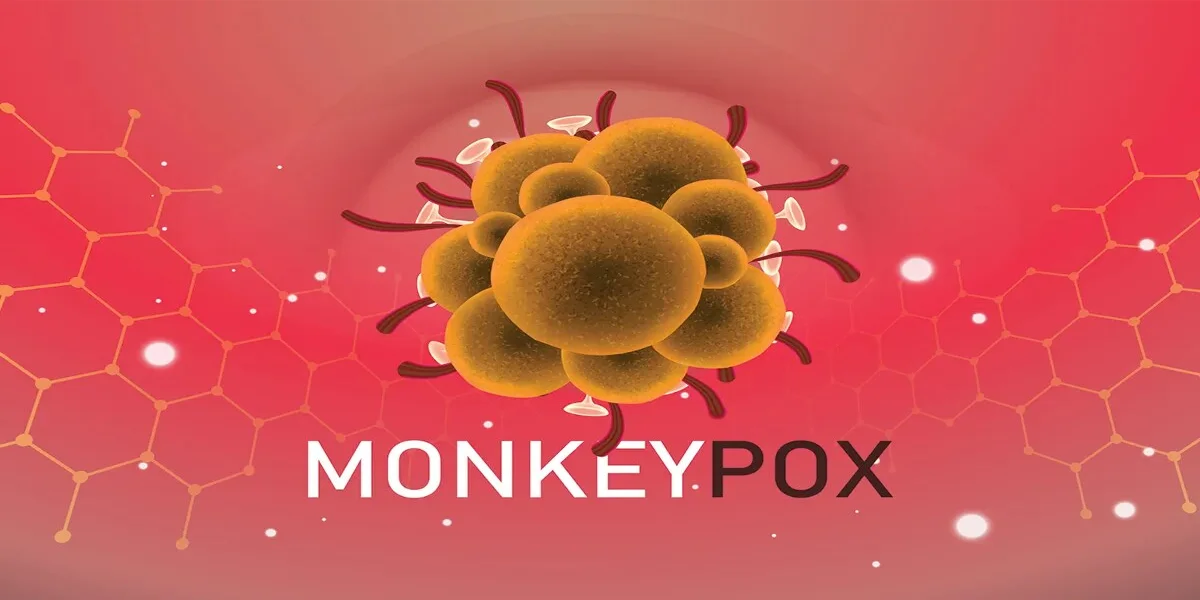What is Monkey pox?
Monkey pox is a rare viral disease caused by the Monkeypox virus, which belongs to the Orthopoxvirus genus. It is closely related to the viruses that cause smallpox and cowpox. Although it was first identified in laboratory monkeys in 1958, the primary hosts of the virus are rodents, such as squirrels, rats, and dormice. Human cases were first reported in 1970 in the Democratic Republic of the Congo, and since then, Monkeypox has become a significant public health concern, particularly in Central and West Africa.
Symptoms of Monkey pox
The symptoms of Monkeypox usually appear 5 to 21 days after exposure to the virus, with most cases presenting symptoms within 7 to 14 days. The disease typically begins with the following flu-like symptoms:
- Fever: A sudden onset of fever, often high, is usually the first symptom.
- Headache: Severe headaches are common.
- Muscle Aches and Backache: Generalized muscle pain and backache.
- Swollen Lymph Nodes: Enlargement of lymph nodes, which distinguishes Monkeypox from smallpox.
- Chills and Exhaustion: Patients often experience chills and feel extremely tired.
After 1 to 3 days (sometimes longer) following the appearance of fever, the characteristic rash of Monkeypox begins to develop. The rash typically progresses through several stages before falling off:
- Macules: Flat, discolored spots.
- Papules: Raised lesions.
- Vesicles: Fluid-filled blisters.
- Pustules: Pus-filled lesions.
- Scabs: The lesions crust over and fall off.
The rash tends to concentrate on the face and extremities, including palms and soles, rather than the trunk. It may also appear inside the mouth, on the genitals, or on the cornea of the eyes. The illness typically lasts 2 to 4 weeks, and the severity of symptoms can vary.
How is Monkeypox Transmitted?
Monkeypox is transmitted to humans through various routes:
Animal-to-Human Transmission:
- Direct Contact: With the blood, bodily fluids, or cutaneous or mucosal lesions of infected animals. In Africa, human infections have been documented through the handling of infected monkeys, Gambian giant rats, and squirrels.
- Bites or Scratches: From infected animals.
- Consumption of Undercooked Meat: Eating poorly cooked meat from infected animals can also be a source of infection.
Human-to-Human Transmission:
- Direct Contact: With respiratory secretions, skin lesions of an infected person, or recently contaminated objects. Transmission can occur through face-to-face contact, such as talking, coughing, or sneezing, which requires prolonged contact.
- Respiratory Droplets: Large respiratory droplets can spread the virus, particularly during prolonged face-to-face contact.
- Fomites: Contact with contaminated materials like bedding or clothing used by an infected person.
Who is at Risk?
- Close Contacts: Family members, healthcare workers, and those living in or visiting endemic regions are at higher risk.
- Children: Young children are more susceptible to severe illness.
- Immunocompromised Individuals: People with weakened immune systems due to conditions such as HIV, cancer treatment, or organ transplantation are more vulnerable.
Diagnosis of Monkeypox
Diagnosing Monkeypox can be challenging, particularly in regions where the disease is rare. The diagnosis is typically based on:
- Clinical Evaluation: Examination of the characteristic rash and other symptoms.
- Laboratory Tests: Confirmatory diagnosis is made through polymerase chain reaction (PCR) testing of samples from skin lesions, swabs, or bodily fluids. Blood tests and serological testing can also help in identifying recent or past infection.
Prevention of Monkeypox
Preventing Monkeypox involves several strategies:
1. Avoid Contact with Wild Animals:
- Limit Interaction: Avoid contact with animals that could harbor the virus, especially in areas where Monkeypox is endemic.
- Proper Cooking: Ensure that all animal products, especially meat, are thoroughly cooked.
2. Personal Protective Measures:
- Hand Hygiene: Wash hands frequently with soap and water or use alcohol-based hand sanitizer.
- Protective Gear: Healthcare workers should use personal protective equipment (PPE) such as masks, gloves, and gowns when dealing with suspected or confirmed cases.
3. Vaccination:
- Smallpox Vaccine: Historically, the smallpox vaccine provided cross-protection against Monkeypox. Newer vaccines, such as the modified vaccinia Ankara (MVA) vaccine, have been approved for Monkeypox prevention and are being used in outbreak settings.
4. Avoid Contact with Infected Individuals:
- Isolation: Isolate patients with confirmed Monkeypox to prevent transmission.
- Safe Practices: Avoid sharing personal items such as bedding, towels, or clothing with someone who is infected.
Treatment of Monkeypox
There is no specific treatment for Monkeypox, but the disease is typically self-limiting, and most patients recover with supportive care. Treatment focuses on:
- Symptomatic Relief: Alleviating symptoms such as fever and pain using over-the-counter medications like acetaminophen or ibuprofen.
- Fluid and Nutritional Support: Ensuring adequate hydration and nutrition.
- Antiviral Medications: In severe cases or for those at high risk (e.g., immunocompromised individuals), Antiviral drugs such as Tecovirimat (TPOXX) or Cidofovir may be used.
Monkeypox vs. Smallpox: Key Differences
Although Monkey pox and smallpox share similarities, there are several differences:
- Causative Agent: Smallpox is caused by the variola virus, while Monkeypox is caused by the Monkeypox virus.
- Lymphadenopathy: Swollen lymph nodes are a hallmark of Monkeypox but are not typically seen in smallpox.
- Mortality Rate: Monkeypox generally has a lower mortality rate compared to smallpox. However, the mortality rate can vary based on the strain of the virus and the population affected.
Global Epidemiology of Monkeypox
Monkeypox was primarily confined to Central and West African countries for several decades. However, sporadic cases have been reported outside Africa, including in the United States, the United Kingdom, and several European countries. The increasing global incidence is attributed to:
- Global Travel: Increased international travel and trade have facilitated the spread of the virus beyond endemic regions.
- Wildlife Trade: The global trade of exotic pets, including rodents that could harbor the virus, poses a significant risk.
- Zoonotic Spillover: Increased interaction between humans and wildlife due to deforestation and urbanization may contribute to zoonotic spillovers.
Recent Outbreaks and Public Health Response
The recent outbreaks of Monkeypox outside of Africa have raised concerns about potential global spread. Public health responses include:
- Surveillance: Enhanced surveillance to identify and isolate cases promptly.
- Contact Tracing: Tracking and monitoring contacts of confirmed cases to prevent further transmission.
- Vaccination Campaigns: Deployment of vaccines to high-risk populations and healthcare workers.
Public Awareness and Education
Raising public awareness about Monkeypox is crucial to preventing its spread. Key messages include:
- Recognizing Symptoms: Educating the public about the signs and symptoms of Monkeypox.
- Promoting Preventive Measures: Encouraging hygiene practices, safe animal handling, and vaccination where available.
- Combating Misinformation: Addressing myths and misinformation about Monkeypox to reduce panic and stigma.





